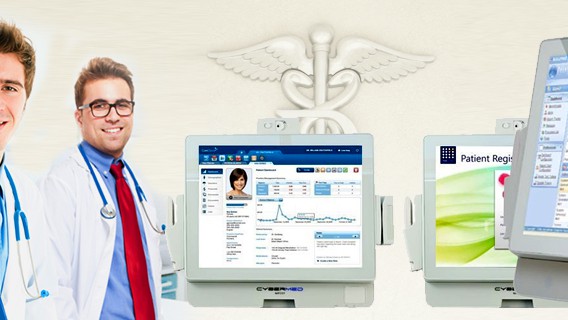The IT challenges and needs for a healthcare facility are far different than those of a traditional enterprise. Mobility, EMR compatibility, as well as 24/7 operability must all be factored in. But even within the healthcare space, needs can vary tremendously. Consider the differences between a hospital in a large metropolitan area vs. a hospital in a rural area. In a lot of rural areas, medical facilities don’t have the luxury of large budgets or the ability to upgrade medical equipment as regularly as a larger hospital in a more densely populated area might have. Extending the life of that machinery in a cost efficient manner is vital for these types of facilities in order to provide the very best in patient care without breaking the bank.
A customer of ours recently reached out to us to let us know how they have managed to extend the life of their mobile x-ray units by integrating a medical grade computer. Their solution turned out to be a stroke of genius, and allowed their facility to move from the analog age into the digital age.
Mobility Matters in Medical Grade Computing
Article Guide
Our customer employed mobile x-ray units in rural areas that needed medical grade computers for control. Consumer-grade computers wouldn’t have fit the bill—carrying around a heavily-wired computer and monitor would have been insufficient and cumbersome for medical staff, so they used medical-grade PCs with hot swappable battery functionality. With a full 16 hours of uptime running on batteries, the staff didn’t need to connect to AC power while using their mobile x-ray medical devices with the medical grade computers. Plus, there’s no downtime with computers featuring hot swappable battery technology ensuring constant healthcare. Internet connectivity is also a concern. In rural areas, internet accessibility isn’t the best which calls for a different type of wireless capability. Many mobile computers are equipped with 3 and 4G wireless technology, so even in the most distant of places medical staff can send patient data to the hospital for review if need be.
Using Surgical Grade Monitors to Enter the Digital Age
Our customer was able to connect the surgical grade monitors to the mobile x-ray devices and get an instant x-ray result on the medical computer’s touch screen. Older technologies required large film emulsion plates that took hours to process within a dark room—that obviously isn’t a mobile solution. With an instant x-ray, our customer was able to zoom in on the patient’s affected area in question and diagnose patients. Instead of having to travel several miles to a distant hospital, wait for an x-ray, process the film, and then have a doctor review the x-rays, it’s done instantly on site so the hospital doesn’t need to purchase expensive and bulky film slates for x-rays. When patient mobility is reduced, it’s up to the medical staff to transport what’s needed in the most crucial times of patient healthcare. Our provided solution fit the needs for our customer and their patients.
Medical Devices in Healthcare IT Aren’t Cheap
Our customer needed a medical grade computer that interfaced with the mobile x-ray machines without a significant price tag. Older medical devices use a serial RS-232 port, which is a legacy port not often found on consumer-grade computers. The option to upgrade to a newer set of x-ray machines wasn’t available with average prices for them ranging well over 100 thousand. In acquiring the medical grade computers, they saved crucial business funds to focus on traveling to patients with hampered mobility.
Medical Computers That Also Meet Certifications
The computers our customer used weren’t just capable of interfacing with x-ray machines for medical staff use. The medical-grade computers they purchased had a full spectrum of patient safety in mind, starting with antimicrobial* properties protecting the computer casing from deterioration and degradation. These mobile computers with the hot swappable battery function were fanless and used internal solid state drives. This greatly improve their reliability and durability, especially in hospital environments where they’re expected to be on 24/7. They also met FDA standards for patient safety with a 60601-1 certification to protect patients from electrical and radiation-related hazards.
Online sources report that 80 rural hospitals have seen closures since 2010 and approximately 600 are suffering financially, numbers likely because patients and hospitals lack mobility. These computers helped the lives of people and kept hospital doors open. There are reasons beyond mobility, however, that prompted our customer to purchase these computers—they’re medically certified for hospital and patient room use. Consumer-grade PCs don’t measure up to the standard that these computers meet! Our customer was satisfied with their purchase of these computers with the hot swappable battery function, the instant x-ray feedback, and the medical certifications to protect patients.
How Medical Grade Computers Improve the Standard of Care in the Medical Profession
August 3, 2015
The face of the healthcare industry has changed drastically in the past decade. Now, the use of devices like medical grade computers in patient rooms, emergency rooms, and operating rooms have allowed healthcare service…
0 Comments6 Minutes
Medical Grade in Technology Explained
September 15, 2023
Is your hospital planning a major deployment of cutting-edge medical computers? At the forefront of your specifications is the requirement that they must be “medical grade.” But what exactly does…
0 Comments9 Minutes
You Can't
Learn from a Pop-up
But we can deliver knowledge to your inbox!
We dive deep in the industry looking for new trends, technology, news, and updates. We're happy to share them with you.
Knowledge, News, and Industry Updates Right in Your Inbox




